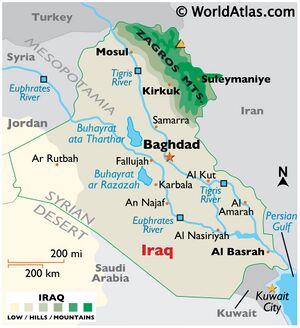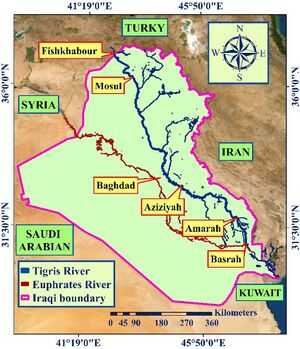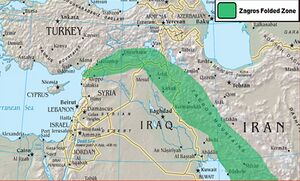Tigris
| Author:Laxman Burdak, IFS (Retd.) |



Tigris is the eastern member of the two great rivers that define Mesopotamia, the other being the Euphrates.
Origin
Pliny[1] mentions Tigris....When its course becomes more rapid, it assumes the name of Tigris, given to it on account of its swiftness, that word signifying an arrow in the Median language. According to Bochart, this was a corruption of the Eastern name Deghel, from which were derived the forms Deger, Teger, and ultimately Tigris.
Jat Gotras Namesake
Jat Places Namesake
- Deeghal = Deghel = Deger = Teger = Tigris (Pliny.vi.31). Deeghal is a large village in Beri tahsil in Jhajjar district of Haryana.
Location
The river flows south from the mountains of southeastern Turkey through Iraq. The Tigris is 1,850 km long, rising in the Taurus Mountains of eastern Turkey about 25 km southeast of the city of Elazig and about 30 km from the headwaters of the Euphrates. The river then flows for 400 km through Turkish territory before becoming the border between Syria and Turkey. This stretch of 44 km is the only part of the river that is located in Syria.
Mention by Pliny
Pliny[2] mentions Voyages to India.....They then arrived at the mouth of the Euphrates, and from thence passed into a lake which is formed by the rivers Eulæus18 and Tigris, in the vicinity of Charax19 after which they arrived at Susa20 on the river Tigris.
18 A river of ancient Susiana, the present name of which is Karun. Pliny states, in c. 31 of the present Book, that the Eulæus flowed round the citadel of Susa; he mistakes it, however, for the Coprates, or, more strictly speaking, for a small stream now called the Shapúr river, the ancient name of which has not been preserved. He is also in error, most probably, in making the river Eulæus flow through Messabatene, it being most likely the present Mah-Sabaden, in Laristan, which is drained by the Kerkbah, the ancient Choaspes, and not by the Eulæus.
19 Called, for the sake of distinction, Charax Spasinu, originally founded by Alexander the Great. It was afterwards destroyed by a flood, and rebuilt by Antiochus Epiphanes, under the name of Antiochia. It is mentioned in c. 31.
20 The Shushan of Scripture, now called Shu. It was the winter residence of the kings of Persia, and stood in the district Cersia of the province Susiana, on the eastern bank of the river Choaspes. The site of Sisa is now marked by extensive mounds.
Mention by Pliny
Pliny[3] mentions Tigris....There is, besides the above, another town in Mesopotamia, on the banks of the Tigris and near its confluence with the Euphrates, the name of which is Digba.1 (27.) But it will be as well now to give some particulars respecting the Tigris itself. This river rises in the region of Greater Armenia,2 from a very remarkable source, situate on a plain. The name of the spot is Elegosine3, and the stream, as soon as it begins to flow, though with a slow current, has the name of Diglito.4 When its course becomes more rapid, it assumes the name of Tigris5, given to it on account of its swiftness, that word signifying an arrow in the Median language.
1 Forbiger is of opinion that this is the same as the Didigua or Didugua of Ptolemy. It was situate below Alpamea. D'Anville takes it to be the modern Corna.
2 The modern Turcomania.
3 Now known as the Plain of Chelat, according to Parisot, extending between Chelat, a city situate on a great lake and the river Rosso, falling into the Caspian Sea.
4 Called Diglith by Josephus. Hardouin states that in his time the name given to the river by the natives was Daghela. This name is also supposed to be another form of the Hiddekel of Scripture. See Genesis ii. 14.
5 According to Bochart, this was a corruption of the Eastern name Deghel, from which were derived the forms Deger, Teger, and ultimately Tigris.
Mention by Pliny
Pliny[4] mentions Arabia....We next come to a city situate on the banks of the Pasitigris, Fora by name, and subject to the king of Charax: to this place people resort on their road from Petra, and sail thence to Charax, twelve miles distant, with the tide. If you are proceeding by water from the Parthian territories, you come to a village known as Teredon; and below the confluence of the Euphrates and Tigris, you have the Chaldæi dwelling on the left side of the river, and the Nomadic tribes of the Scenitæ on the right.
History
According to Pliny and other ancient historians, the Euphrates originally had its outlet into the sea separate from that of the Tigris.[5]
Baghdad, the capital of Iraq, stands on the banks of the Tigris. The port city of Basra straddles the Shatt al-Arab. In ancient times, many of the great cities of Mesopotamia stood on or near the Tigris, drawing water from it to irrigate the civilization of the Sumerians.
Notable Tigris-side cities included Nineveh, Ctesiphon, and Seleucia, while the city of Lagash was irrigated by the Tigris via a canal dug around 2400 B.C.
Ram Sarup Joon[6] writes....In the eight generation of Krishna was King Ushinar whose son was Shavi, more popularly known as Shiv Ji. He married Sati and Parbati and had two sons Ganesh or Ganpati and Somi Kartik. Ganesh or Ganpati are not names but titles meaning head of a tribe. Jats have a big Gotra called Shavi. Iran was once known as Shavi Desh as mentioned by Huen Tsang and Fa Hein in the account of their travels to India. They have stated that through Tartar, Kashgar and Pamir they reached Shavi Country. Shavi is even today remembered in Iran as Prophet Shish. A shrine on his name is situated on the bank of River Tigris. A province of Iran was called Shavisthan now known as Seistan. These Shavi
History of the Jats, End of Page-29
People came to be known as Shavisthani, Shavisthans or Scythians. A great Scythian writer Abul Ghazi has called himself a Jat of Chandravanshi dynasty. He also writes that the mother of Scythians was the daughter of Ahilya Devi.
Religion and mythology
The Tigris appears twice in the Bible. In the Book of Genesis, where it is the third of the four rivers branching off the river issuing out of the Garden of Eden.[7] Daniel received one of his visions "when I was by that great river the Tigris".[8]
In Sumerian mythology, the Tigris was created by the god Enki, who filled the river with flowing water.[9]
In Hittite and Hurrian mythology, Aranzah (or Aranzahas in the Hittite nominative form) is the Hurrian name of the Tigris River, which was divinized. He was the son of Kumarbi and the brother of Teshub and Tašmišu, one of the three gods spat out of Kumarbi's mouth onto Mount Kanzuras. Later he colluded with Anu and the Teshub to destroy Kumarbi (The Kumarbi Cycle).
Arrian[10] writes....Alexander now ordered Hephaestion to lead the main body of the infantry as far as the Persian Sea, while he himself, his fleet having sailed up into the land of Susiana, embarked, with the shield-bearing guards and the body-guard of infantry; and having also put on board a few of the cavalry Companions, he sailed down the river Eulaeus to the sea.[1] When he was near the place where the river discharges itself into the deep, he left there most of his ships, including those which were in need of repair, and with those especially adapted for fast sailing he coasted along out of the river Eulaeus through the sea to the mouth of the Tigres. The rest of the ships were conveyed down the Eulaeus as far as the canal which has been cut from the Tigres into the Eulaeus, and by this means they were brought into the Tigres. Of the rivers Euphrates and Tigres which enclose Syria between them, whence also its name is called by the natives Mesopotamia,[2] the Tigres flows in a much lower channel than the Euphrates, from which it receives many canals; and after taking up many tributaries and its waters being swelled by them, it falls into the Persian Sea.[3] It is a large river and can be crossed on foot nowhere as far as its mouth,[4] inasmuch as none of its water is used up by irrigation of the country. For the land through which it flows is more elevated than its water, and it is not drawn off into canals or into another river, but rather receives them into itself. It is nowhere possible to irrigate the land from it. But the Euphrates flows in an elevated channel, and is everywhere on a level with the land through which it passes. Many canals have been made from it, some of which are always kept flowing, and from which the inhabitants on both banks supply themselves with water; others the people make only when requisite to irrigate the land, when they are in need of water from drought.[5] For this country is usually free from rain. The consequence is, that the Euphrates at last has only a small volume of water, which disappears into a marsh. Alexander sailed over the sea round the shore of the Persian Gulf lying between the rivers Eulaeus and Tigres; and thence he sailed up the latter river as far as the camp where Hephaestion had settled with all his forces. Thence he sailed again to Opis, a city situated on that river.[6] In his voyage up he destroyed the weirs which existed in the river, and thus made the stream quite level. These weira had been constructed by the Persians, to prevent any enemy having a superior naval force from sailing up from the sea into their country. The Persians had had recourse to these contrivances because they were not a nautical people; and thus by making an unbroken succession of weirs they had rendered the voyage up the Tigres a matter of impossibility. But Alexander said that such devices were unbecoming to men who are victorious in battle; and therefore he considered this means of safety unsuitable for him; and by easily demolishing the laborious work of the Persians, he proved in fact that what they thought a protection was unworthy of the name.
1. The Eulaeus is now called Kara Su. After joining the Ooprates it was called Pasitigris. It formerly discharged itself into the Persian Gulf, but now into the Shat-el-Arab, as the united stream of the Euphrates and Tigris is now called. In Dan. viii. 2, 16, it is called Ulai. Cf. Pliny, vi. 26, 31; xxxi. 21.
2. The Greeks and Romans sometimes speak of Mesopotamia as a part of Syria, and at other times they call it a part of Assyria. The Hebrew and native name of this country was Aram Naharaim, or "Syria of the two rivers."
3. The Tigris now falls into the Euphrates.
4. Cf. Arrian, iii. 7, supra; Curtius, iv. 37.
5. Cf. Strabo, xvi. 1; Herodotus, i, 193; Ammianus, xxiv. 3, 14.
6. Probably this city stood at the junction of the Tigris with the Physcus, or Odoneh. See Xenophon (Anab. ii. 4, 26); Herodotus, i. 189; Strabo, (xvi. 1) says that Alexander made the Tigris navigable up to Opis.
External links
References
- ↑ Natural History by Pliny Book VI/Chapter 31
- ↑ Natural History by Pliny Book VI/Chapter 26
- ↑ Natural History by Pliny Book VI/Chapter 26
- ↑ Natural History by Pliny Book VI/Chapter 32
- ↑ Pliny: Natural History, VI, XXVI, 128-131
- ↑ History of the Jats/Chapter II,p. 29-30
- ↑ Genesis 2:14
- ↑ Daniel 10:4
- ↑ Jeremy A. Black, The Literature of Ancient Sumer, Oxford University Press 2004, ISBN 0-19-926311-6 p. 220-221
- ↑ The Anabasis of Alexander/7a, Ch.7

